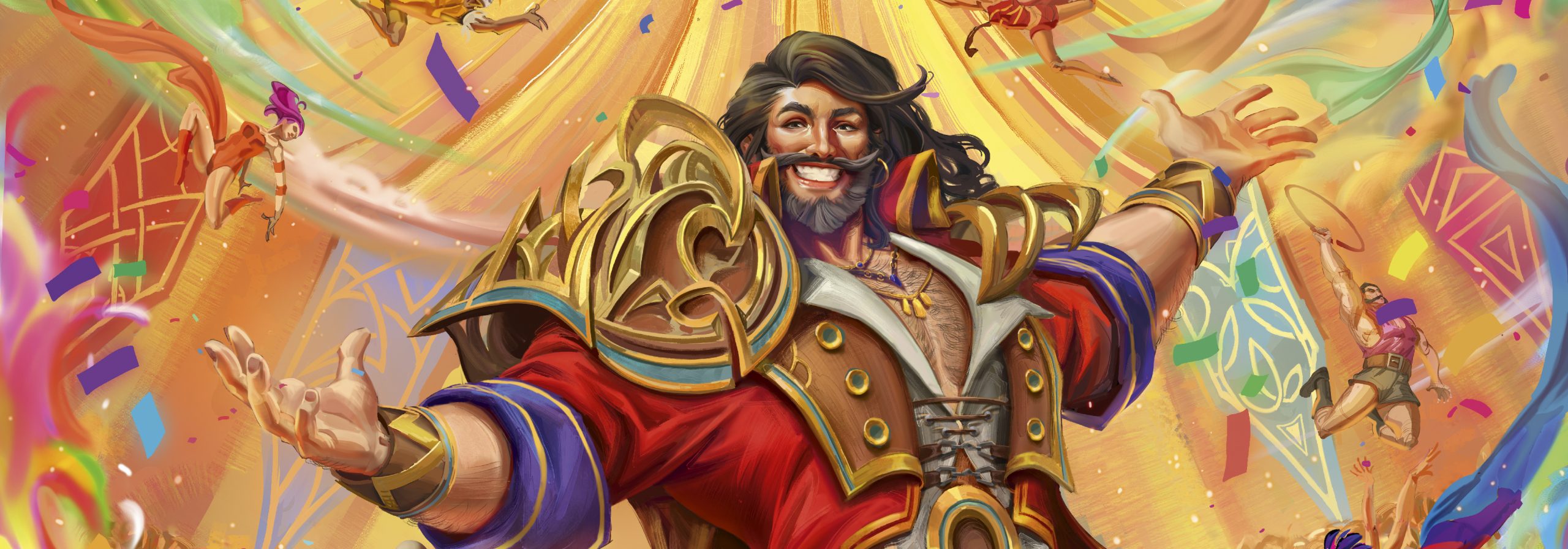We've invited some guest writers to contribute to fabtcg.com for the Skirmish season. Matt di Marco is known for both video and written content, including interviews, articles, and most recently, broadcasting. This is the fourth article in his five-part Elevating Your Game series.
Elevating Your Game From Casual to Competitive
Part Four: Establishing Your Edge
You’ve been putting in the work, and practicing like a fiend. You know your deck inside out, and all your neurons are so tightly wired that you’re playing multiple games in your mind at the same time, Magnus Carlsen style. Your confidence is soaring, and your networking efforts have you firmly embedded in a secret Discord community that you assure people doesn’t exist. All your hard work is paying off, and you’ve maybe even bubbled out of a Top 8 finish. All signs point to success being right around the corner, but there are a few extra layers that you’ll need to dig into in order to convert on a win.
It is important to first appreciate that you’ve made progress. When you decided to go from a casual card player to a competitively driven grinder, the path was long and littered with snares. Now you’re well supported and better equipped to kick open the doors of your local game shop like you’re entering a saloon. Time to get a win under your belt. There are a few new territories to explore and familiarize yourself with before you can truly have all of your mojo working.
The Ebb and Flow of the Meta Game
Back when you were starting this journey, one of the critical decisions you had to make was which hero you wanted to play. Honing the field to the competitively viable options called for a broad glance at the overall meta game. Now that you’re firmly entrenched as a Rhinar main, Katsu stan, or Lexi diehard, it is time to revisit that ever shifting climate in more focused detail.
At a glance, metas will often look stagnant. The same heroes you’ve seen Top 8 countless Pro Quests are accounting for the lion’s share of the representation at the most recent Calling. Nothing has seemingly changed from a macroscopic view, but looking closer will tell a more informative story. Understanding the ebb and flow of a meta goes beyond how many heroes are appearing, but more so how those heroes are being played. What approach to the game are players taking when at the helm of these familiar decks?
Your deck may feel invincible one weekend, only to feel punchless the next. This isn’t bad luck, it is merely the tides changing that you perhaps didn’t anticipate. Your ice Lexi list that was punishing aggro decks may have walked into a slower meta game ripe with Prisms and Oldhims. Even the Starvos and Viserais have adapted to the change, altering their win conditions to a slower grind or OTK respectively.

Calling: Indianapolis winner Michael Hamilton walked away with his second major tournament trophy piloting Bravo, Star of the Show. Choosing what is the consensus best hero in the format isn’t much of a surprise, but what was noteworthy was how he built the deck. Ahead of casting the finals match, Bryan Gottlieb and I spent a decent chunk of time going through his registered list and circling “abnormalities”. They were unorthodox choices that strayed away from the common wisdom of how Starvo should be built in the current environment. What we quickly recognized was how Hamilton predicted what the scene would look like; the pace and aggression levels of the field were adeptly predicted by Hamilton to require a more methodical approach. He took the formula and determined what the variables would be and churned out a list that could be strong from a conventional standpoint, but also built to easily pivot to match the meta game he anticipated would bubble to the top. His list looked quite different from the rest of the field, and what seemed like odd card choices ultimately translated into another Calling title to his name.
You’ll need your finger on the pulse at all times. Without the great melting pot that is a digital client, the grander scheme of what people are playing will shrink down into micro-metas, and these are easier to absorb and react to. Though taking home a National Championship is a long-term dream, your focus right now is on winning your local Skirmish or having a strong run at the next wave of Pro Quests. These smaller regional metas will be simpler to understand, as you’ll not need to worry about what’s going on 500 kilometers away. You just need to know what the usual suspects are up to. These metas aren’t prone to seismic shifts that a Pro Tour or World Championship may be subjected to. You just need to know what Steve and Sally play, and be sure that your dial is tuned to counter that frequency. This is where your networking will help. It sounds like espionage, but the secret agent fantasy falls flat when you realize that effective scouting is merely the result of keeping your eyes peeled in community Discord chats or just remembering what people played last week. Being mindful in this way is an edge in itself, and one you can bank on easily.
Your Circus Needs A Good Sideshow
When you’re shuffling up for your first match in a tournament, you should be presenting them 60 cards to cut. It is the bare minimum you can legally play in Classic Constructed. Exceeding the 60 will introduce more variance, meaning you’ll be seeing your most important and powerful cards less frequently. By adhering to the 60 minimum, your games will feel a lot more fluid, more reliable, and your results will reflect that. Your deck should be as optimized as possible; almost no deck needs to go above that 60 threshold. Your sideboard is your opportunity to give your hero more tricks up their sleeve than a fully kitted Mandalorian.
Honestly, if you could, you’d probably play closer to 48 cards. In reality, the main story your deck wants to tell shouldn’t exceed a core set of about 45 to 50 cards that truly do what your deck is designed to do. Your main Ninja combo lines, your powerful attacks like Enlightened Strike, some combat tricks like red Razor Reflex and Ancestral Empowerment, and voila! You’ve got the nucleus of a deck with about 10 cards to spare. You’ve got an opportunity now to fill the remainder of your deck with choices relating to your read on the meta, and which hero your opponent has revealed.
Sideboarding is a skill in itself, and is drastically underrated by average players looking to win more high-level matches. With an 80-card limit, you’re afforded a lot of leeway to truly fine tune your deck to best endure the storm it’s going to be staring down. Think of your deck as a car, and your sideboard as your tires. Your opponent is like the weather. Sometimes it is sunny, other times it is raining. Sometimes it is a snowy mess and you’ve got a foot of snow to work through. If you have the same 60 cards, you’re basically trusting that your set of tires will perform under all these conditions successfully. As a lifelong Canadian, trust me: slam some winters on your ride if you wanna get home in a blizzard.

On those sunny days, any tire will get you home. These are the matchups where your gameplan won’t really sway. You’re already favoured, so the best way to fill the void is with cards that will support your existing strategy. There will always be cards that fit the bill, even if they are only marginally better than another choice. As a Guardian, maybe your matchup already feels good against Dash. No need to devote specific disruption to beat a Mechanologist, but choosing to include a card like Spinal Crush is strictly better than Crush Confidence in this case. You’re not particularly worried about Dash, but even the sunny days can be optimized. Against Levia, for example, Crush Confidence may be a better choice to eliminate them dodging the Blood Debt tax. Easier matchups still have room to be slightly better.
The tougher matchups are where sideboarding can make or break your performance. This is where you need to dig deep into your pile of tricks and pull out some real hocus pocus. Outside of that core set of 50ish cards, your sideboard is like having a Get Out Of Jail Free card for specific scenarios. Cards like red Unmovable can be considered sideboard all-stars because of how clutch they are in a multitude of matchups. Many decks will run them to shut down major power plays like a dominated Crippling Crush. It is a universal rescue in the face of dire circumstances, and a card many frequently auto-include in their sideboard strategy.
Less broadly applicable sideboard options like Snag have seen the rounds in metas past, whereas other specific matchups will see a Ninja player look to attain Zen State to deflate an aggressive Viserai. Finding the right recipe to beat an unfavourable matchup isn’t terribly difficult if you know the cards available to you. The tough part is ensuring you’ve got the right spices on the rack ready to go. After your core deck, your equipment slots, and your weapon, you’ll have room to build a suitable sideboard, but your runway isn’t infinite. You’ll need to choose wisely and find the options that will turn a bad matchup into a 50-50.
Have A Plan, Be Ready To Pivot
If you tune into a high level game, say a feature match being streamed from a Calling, all you’re privy to are the players playing the game. What you don’t have the luxury of are the players consulting their notes about the matchup at hand. The world class competitors will likely have all this stored safely away in their mind, able to access their map to victory as soon as their opponent tells them the hero they are playing. Having a plan – and sticking to a plan – is a discipline you need to work on. Your deck has a gameplan, but it will bend to the circumstances from turn to turn. Knowing the best approach, and how to conquer your opponent’s biggest swings, is crucial to success, but so is maintaining discipline when you’re enticed by a window of opportunity.
During a Pro Quest at Hairy Tarantula in Toronto, my only loss in the swiss rounds was to a Chane player. I was on Prism and my notebook clearly read FATIGUE. I sideboarded correctly and followed those orders militantly until I drew a hand that looked way too juicy to throw away for blocks. It was a fiery hand of heralds, including Herald of Erudition. I did some calculations in my mind and decided to tank some damage in order to be able to swing back and bring them closer to zero. Ultimately, I ended up losing by a few points of health after they managed to beat me on their final turn, decking themselves out in the process. My enticement by that forbidden fruit resulted in me losing sight of the game plan and taking too much damage on that crucial turn. Had I committed those heralds to block, Chane wouldn’t have killed me, and the player would have drawn empty on the next turn. It was a moment of weakness. I filed that lesson away, never falling victim to the allure of a strong hand while on a fatigue strategy.
The deck you’re shuffling up should also have contingencies and a solid Plan B. You’re not always going to get a free ride to just play your cards the way you want. To quote Sean Bean: “one does not simply walk into…” well you know the meme. Expect resistance! Sticking to a plan that is working is very different from being stubborn.

Evaluating your lines to victory is an ongoing exercise in a game, so be sure you’re aware of how you can win. Playing against an aura based Prism player can mean that you’ll be on aura cleaning duty for a while, chipping away at their life total as you go. Eventually, however, they may sneak out a strong set of turns, and suddenly their auras are too much for you to handle. Reevaluating your game plan might mean ignoring the auras and turning the grind into a race. This pivot is a fork in the road that a lot of players face against Prism, but many will decide that the original plan is still the best. Flesh and Blood is a game of adapting from match to match, turn to turn, attack to attack. Be sure your pride isn’t guiding your decisions.
In the next and final part of this series, I’ll be tackling some of the things to avoid as you progress to being a competitive player.
Matt di Marco is a competitive Flesh and Blood player and author of content relating to gameplay and strategy. The opinions expressed in the above article are his own and do not necessarily reflect the views of Legend Story Studios.